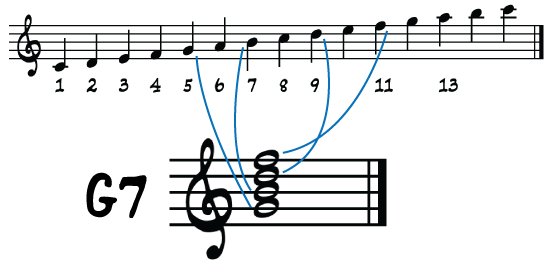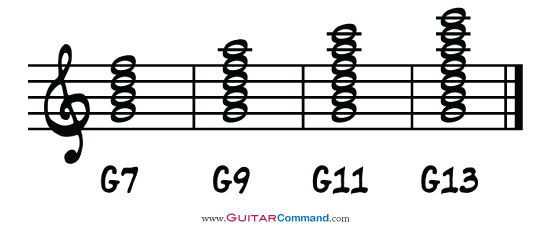In the previous article in this series, we learned about guitar chord theory, and examined major, minor, suspended and many other types of chord.
This article will cover dominant chords, including seventh, ninth, eleventh and thirteenth chords.
The article is aimed at guitarists, and includes example chord shapes to play. However, any musician wishing to know more about dominant chords and their use in popular music will find this article useful. Read on to find out how dominant chords are formed and how they are used...
What Are Dominant Chords?
Dominant chords are built from the fifth degree of a diatonic scale. In plain English, this means that you use the fifth note of a scale such as a major scale as the bottom (root) note of your dominant chord. To this root note, you add the third and fifth notes of your new chord (these would be the seventh and ninth notes of your original scale).
In popular music, the term 'dominant chord' usually means dominant seventh or extended seventh chords created from the notes of a major scale. These are the chords we will be examining here.
A C major scale contains 7 notes: C D E F G A B.
The dominant chord from this scale would have a root of G, a third of B (the seventh note of C major), and a fifth of D (the ninth note - you have to imagine that the scale is extended another octave).
To make a dominant seventh chord, a further note is added to the triad. This note is a third above the fifth note. In our dominant chord built from the C major scale, the seventh note would be an F.

Dominant 7th chords can be further extended to create ninth, eleventh and thirteenth chords. Read more about extended seventh chords below.
How Are Dominant Chords Used In Music?
Dominant chords create a feeling of 'expectancy' in music. This expectancy is resolved when the next chord is the tonic chord. This resolution effect is used by composers and songwriters in all kinds of music.
[ad name="Google Adsense Lge Rec"]
Play this chord sequence to hear how strong the pull back to the tonic is.

Notice how you've created a musical cliffhanger: after the G7 chord your ears want to hear the final C chord!
The expectancy / resolution effect of dominant chords can be used in many ways, including: to reinforce the original key, to provide a pleasing end to a musical phrase, or to introduce a new key.
Dominant chords are not always resolved to the tonic chord, and additional musical effects are created when dominant chords are followed by chords such as the vi (Am in the key of C) or IV (F in the key of C). Try playing these chords after the G7 in the 'cliffhanger' progression above.
Extended Dominant Chords
Dominant seventh chords are often extended to create dominant ninth, eleventh and thirteenth chords (the 'dominant' part of their names is often omitted). They are all based on the dominant seventh chord. Their chord symbols are 9, 11 and 13 respectively. The additional note is always a third higher, i.e. 2 notes further up the diatonic scale from which the dominant chord was formed.
• The ninth chord contains the ninth note in addition to the notes from a dominant seventh chord.
• The eleventh chord contains all the notes from a ninth chord, plus the eleventh note.
• The thirteenth chord contains all of the notes from an eleventh chord, plus the thirteenth note.
The diagram below shows the chords that are created when a G dominant chord is extended. The G dominant chord is built from the C major scale.

Major triad formed from 5th note of major scale: G B D
Add seventh note (i.e. seven notes up from G) to create dominant seventh: G B D F
Add ninth note to create dominant ninth: G B D F A
Add eleventh note to create dominant eleventh: G B D F A C
Add thirteenth note to create dominant thirteenth: G B D F A C E
As each note is added, the resultant chord, while still recognizably dominant, acquires a new sound. Listen to the difference in sound between the dominant guitar chords below:

Note: ninth, eleventh and thirteenth notes are the same notes as the second, fourth and sixth notes. However, the terms 'ninth' 'eleventh' and 'thirteenth' are used because the chord is extending beyond the seventh note. See the Guitar Chords Interval Chart here for more information.
[ad name="Google Adsense Lge Rec"]
If You Don't Know An Extended Chord!
Because each extended dominant chord contains the notes of a dominant 7th chord, you can always play a standard 7th chord in their place. This is handy if you've either forgotten the extended version, or if the chord changes are happening too quickly for you to play the full versions.
Missing Notes In Guitar Chords
Notes are often omitted from guitar chords. This is because of physical limitations of both the instrument and of the human hand! In music theory, many chords contain more than six notes if written out in full (the G13 above contains 7 notes). In order to play these chords on the guitar, non-essential notes (notes that don't have a large influence on the sound of a chord) can be omitted.
Conclusion
This article contains a lot of information, so if you have got this far, congratulations! If you have any questions, feel free to ask them in the comments below. In the next article, in this series, we look at altered chords.



Dominant chords are used as root/1 chords too, not just as cliffhangers. I never see that as part of their definition though and I can’t figure out why.